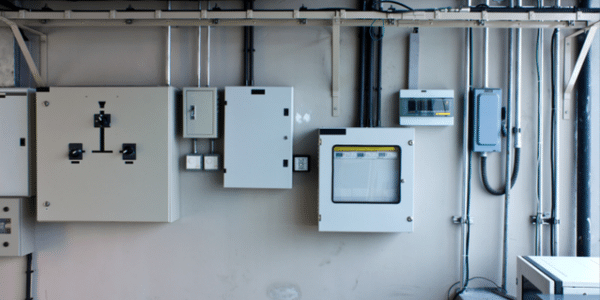The Importance of Proper Ventilation in Electrical Fiberglass Boxes: Tips for Design and Installation
6/14/20244 min read


Proper ventilation in electrical fiberglass boxes is essential for maintaining the efficiency and safety of electrical systems. One of the primary functions of ventilation is to facilitate heat dissipation. Electrical components generate heat during operation, and without adequate ventilation, this heat accumulates, leading to increased internal temperatures. Excessive heat can cause components to overheat, which not only impacts their performance but also shortens their lifespan.
Overheating poses significant risks, including potential equipment failure. When internal temperatures rise, sensitive electronic components may malfunction or degrade more rapidly, resulting in costly downtime and repairs. Additionally, overheating can create fire hazards, especially in environments where flammable materials are present. Proper ventilation helps mitigate these risks by ensuring that heat is efficiently expelled from the enclosure, maintaining a stable internal environment.
Another critical aspect of ventilation is compliance with regulatory standards and industry best practices. Various standards, such as those set by the National Electrical Code (NEC) and Underwriters Laboratories (UL), outline specific requirements for the design and installation of electrical enclosures, including ventilation. Adhering to these guidelines not only ensures safety but also enhances the reliability and longevity of the electrical systems housed within the fiberglass boxes.
In addition to regulatory compliance, industry best practices recommend incorporating features like vents, louvers, and fans into the design of electrical fiberglass boxes. These elements facilitate airflow, preventing the build-up of heat and moisture, which can also be detrimental to electrical components. By following these practices, designers and installers can ensure that the electrical systems operate within their optimal temperature range, thereby enhancing overall performance and reducing the likelihood of failures.
In summary, proper ventilation in electrical fiberglass boxes is paramount for effective heat dissipation, preventing overheating, and ensuring the safe and efficient operation of electrical components. By meeting regulatory standards and implementing industry best practices, one can significantly mitigate risks and enhance the durability and performance of the electrical systems.
Design Considerations for Effective Ventilation
Ensuring effective ventilation in electrical fiberglass boxes requires meticulous design considerations to maintain optimal performance and safety. Selecting appropriate materials is critical, as the inherent properties of fiberglass provide excellent durability, electrical insulation, and resistance to environmental factors. However, the integration of vents and cooling fans is paramount to facilitate adequate airflow and prevent overheating.
Strategically placing ventilation openings is another essential aspect. Proper placement ensures even distribution of air, thereby enhancing the cooling efficiency. Implementing vents at both the top and bottom of the fiberglass box can leverage natural convection, where warmer air rises and exits through the top vents, while cooler air enters through the bottom. This principle of natural convection is highly effective in passive cooling systems.
In situations where natural convection is insufficient, forced ventilation can be employed. This involves the use of cooling fans to actively circulate air within the fiberglass box, ensuring that temperature levels remain within safe limits. The selection and positioning of these fans should be based on the specific thermal load and design constraints of the electrical components housed within the box.
Airflow management is another integral component of effective ventilation design. It is crucial to ensure that the airflow path is unobstructed and that the velocity of the air is sufficient to carry away the heat generated by the electrical equipment. Computational fluid dynamics (CFD) modeling can be beneficial in predicting airflow patterns and optimizing the design accordingly.
Environmental factors such as dust, moisture, and corrosive elements also play a significant role in the ventilation system's longevity and efficiency. Incorporating filters and protective covers can mitigate the ingress of dust and particulate matter, while moisture barriers and corrosion-resistant coatings can safeguard against environmental degradation. These considerations help maintain the integrity of the ventilation system and ensure the reliable operation of electrical components within the fiberglass box.
Best Practices for Installation and Maintenance
Proper installation and maintenance of ventilation systems in electrical fiberglass boxes are crucial for ensuring optimal performance and longevity. To begin with, the installation process must adhere to specific guidelines to guarantee the effectiveness of the ventilation. Securely fastening ventilation components, such as fans and vents, is imperative. This step ensures that the components remain in place and function correctly, preventing any potential disruptions or failures.
Furthermore, achieving airtight seals where necessary is essential to maintain the integrity of the ventilation system. An airtight seal prevents the ingress of dust, moisture, and other contaminants, which could otherwise compromise the internal environment of the electrical fiberglass box. Utilizing appropriate sealing materials and techniques is vital to achieving this objective.
Maintenance of the ventilation system is equally important. Regular inspection is a fundamental aspect of maintenance. Conducting periodic checks allows for the early detection of any issues, such as blockages or wear and tear, that could affect the system's performance. Cleaning the vents is another critical maintenance task. Over time, dust and debris can accumulate, obstructing airflow and reducing efficiency. Therefore, it is recommended to clean the vents periodically to ensure unobstructed ventilation.
Additionally, replacing filters is a necessary maintenance activity. Filters play a significant role in preventing contaminants from entering the electrical fiberglass box. However, they can become clogged or degraded with use. Replacing filters at regular intervals ensures that the ventilation system continues to provide clean and effective airflow.
Regular monitoring and troubleshooting are also crucial to maintain the effectiveness of the ventilation system. Monitoring involves keeping track of the ventilation system's performance, identifying any irregularities, and addressing them promptly. Troubleshooting, on the other hand, involves diagnosing and resolving any issues that arise, ensuring the system operates smoothly over time.
Incorporating these best practices for installation and maintenance will significantly enhance the reliability and efficiency of ventilation systems in electrical fiberglass boxes, contributing to their overall functionality and durability.
